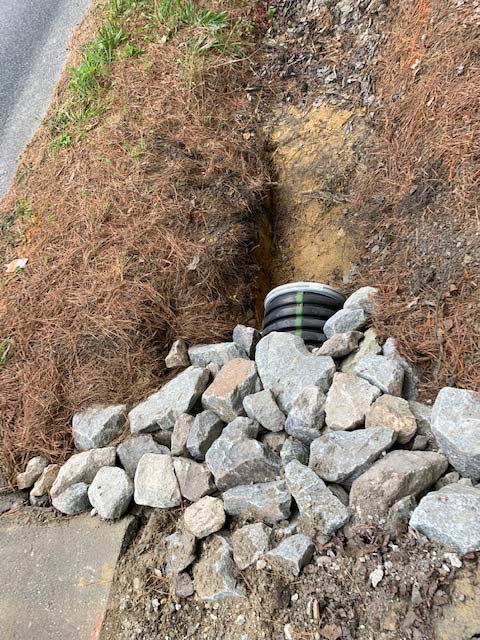Culvert Installment Made Easy: Step-by-Step Overview for Success
Installing culverts might seem like a simple job, however making certain a successful outcome calls for careful planning and execution. From choosing the appropriate culvert dimension to incorporating proper drainage steps, each step in the installment procedure plays an essential duty in the functionality and longevity of the culvert system. By adhering to a methodical strategy and paying focus to crucial information, the setup can proceed smoothly, lessening prospective problems down the line. Keep tuned to discover the vital actions and factors to consider that can make culvert installment a seamless and successful venture.
Selecting the Right Culvert Dimension
Picking the appropriate culvert size is essential for ensuring efficient water circulation and structural integrity in culvert installment tasks - Pad Construction. The dimension of the culvert straight influences the flow capacity of water with the framework. A culvert that is as well small can bring about flooding and overflow, while one that is too big may lead to decreased water velocity, potentially causing sediment buildup and blockages
To identify the appropriate culvert size, aspects such as the watershed location, top circulation rates, and hydraulic effectiveness need to be thoroughly considered. Calculations based on these criteria assist in picking a size that can effectively handle the expected water quantity while decreasing the threat of obstructions and architectural failure.
It is vital to seek advice from design guidelines and requirements to make sure that the selected culvert dimension fulfills the project needs and neighborhood policies (Pad Construction). By picking the ideal culvert dimension, task supervisors can optimize water flow, protect against possible problems, and enhance the overall efficiency and longevity of the culvert installment
Preparing the Installation Site
Efficient culvert installation requires meticulous preparation of the installation site to ensure ideal structural support and functionality. Before commencing the setup process, it is vital to clear the site of any particles, greenery, or blockages that could restrain the culvert's positioning. Making certain a level foundation is important for the correct alignment and stability of the culvert. This might entail grading the site to create a smooth, even surface area that can properly sustain the weight of the culvert and any type of anticipated lots. In addition, appropriate compaction of the soil beneath the culvert is necessary to stop resolving or moving over time.
Moreover, it is essential to think about variables such as soil structure, groundwater degrees, and ecological influences when preparing the installment website. Carrying out a complete site analysis can assist identify any possible difficulties or threats that may affect the culvert's performance. By making the effort to prepare the setup website correctly, you can assist ensure a successful culvert setup that meets structural requirements and ensures long-term capability.
Placing the Culvert Properly

The grade at which the culvert is placed is important for maintaining a proper incline for water flow. A progressive slope assists stop pooling and promotes effective drain. Furthermore, the culvert needs to be oriented properly to make certain that the inlet and electrical outlet remain in the correct areas. This alignment is vital for the culvert to operate efficiently in managing water flow.
Backfilling and Compacting the Soil
Proper backfilling and compaction of the soil around the culvert is necessary to make sure stability and protect against possible concerns in the future. When the culvert is appropriately placed, the next crucial step is to backfill the location around it with ideal product. The backfill material ought to be without rocks, particles, and natural matter to stay clear of damage to the culvert. It is suggested to utilize granular product such as sand or crushed rock for backfilling, as it provides good drain and compaction residential or commercial properties.
After placing the backfill material, it is important to portable it in layers of uniform density. Using a compactor or a mechanical tamper, compact the soil carefully to stay clear of harming the culvert. Compaction assists in lowering the possibilities of settlement and makes certain consistent assistance around the culvert. It is vital to portable the dirt equally on all sides of the culvert to maintain its structural integrity.
Correct backfilling and compaction not only give security to the culvert however additionally help in preventing soil erosion and preserving the long life of the culvert system.
Making Sure Proper Drainage Integration
Integrating effective drain solutions plays an essential function in the overall functionality and longevity of culvert installations. Appropriate water drainage integration is essential for taking care of water circulation, stopping disintegration, Pad Construction and guaranteeing the structural honesty view publisher site of the culvert system. To achieve this, it is vital to develop an extensive drainage strategy that considers elements such as the volume of water anticipated, the topography of the location, and the sort of soil existing.

Additionally, incorporating functions like erosion control steps, such as riprap or vegetation, can further improve the performance of the water drainage system. By meticulously planning and applying these drain solutions, culvert installments can work successfully and endure the test of time.
Final Thought
In final thought, appropriate culvert installment is essential for keeping efficient drain systems. By selecting the appropriate culvert dimension, preparing the setup site, putting the culvert appropriately, backfilling and condensing the soil, and making sure proper drainage combination, success can be attained. Adhering to these actions will certainly assist ensure the durability and performance of the culvert, eventually adding to the total success of the water drainage system.